Mount Kinabalu - a Botanists View
Dr. L. K. Wade
North Vancouver, British Columbia
Ever since a mid-960's fifteen month sojourn at 11,600' in the Pindaunde Valley of New Guinea's 14,793' Mt. Wilhelm, I have cherished an ambition to visit Borneo's Mt. Kinabalu, at 13,455' the highest mountain between New Guinea and the Himalayas. The two great peaks have much in common, their height and great physical mass, their locations on very large tropical islands near or on the equator, their almost unbelievably rich floras, in both cases derived from both Asian and Australian origins, and of perhaps greatest interest here, their rhododendron floras. Although the islands of Borneo and New Guinea are separated by about 800 miles of island-studded sea, both are part of the botanical province of Malesia, which consists, in contrast to the political entity of Malaysia, of the islands of Indonesia and Malaysia, the Malay Peninsula, the Philippines, and New Guinea with its associated islands. Perhaps nowhere else on earth does such a mixture of plant genera of northern temperate, southern temperate, and tropical affinities occur as on the high mountains of this great botanical province, making these mountains objects of unequalled biogeographical interest. One of the prominent genera of distinctly Asian origin found in the mountains throughout Malesia is of course
Rhododendron
, which, according to Sleumer, numbers in this region some 280 species. All but five of these belong to the lepidote section Vireya, which interestingly enough has only two species outside Malesia. One scenario to account for this curious distribution would have early Vireya section rhododendrons or rhododendrons ancestral to this section migrating southeastwards into Malesia from Asia and there undergoing adaptive radiation on a dramatic scale, the resulting species occupying many diverse niches and exhibiting great diversity in size, colour, and form. While there are no rhododendron species common to both Mt. Kinabalu and Enduwakombugu, to use the more evocative local name for Mt. Wilhelm, there are many parallels between the two rhododendron floras, in terms of number of species, size and habit of plants, flower sizes, shapes, colours, and habitats. At the same time there are some striking differences which will be dealt with later.
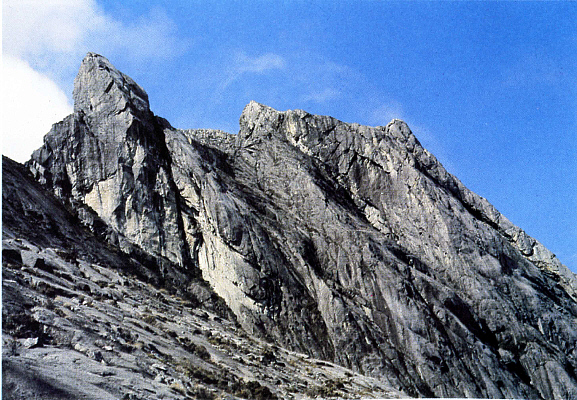
|
The summit ridge of Mt. Kinabalu
All photos by author
|
Mt. Kinabalu stands alone as an impressive granitic mass which has been intruded through the previously overlying sedimentary strata which comprise much of the rest of the island of Borneo. Several other peaks, including Trus Madi and Tambuyukon, are over 8'000' high, but no other peaks approach the height and mass of Kinabalu. Thus it is not surprising to discover that ten of Kinabalu's twenty-seven known rhododendron species are endemic to Mt. Kinabalu, that is, they are found nowhere else. By comparison, Enduwakombugu, although 1338' higher and even more massive, is but the tallest in a chain of high peaks in the Bismarck Range, one of which, Mt. Herbert is connected to it by a long alpine ridge nowhere lower than about 10,000'. To my knowledge, none of the rhododendrons on Enduwakombugu are restricted to it, although all are endemic to New Guinea. Another obvious difference between the two mountains is the total absence on Mt. Kinabalu of one of the most widespread tropical mountain vegetation zones, the subalpine tussock grassland, which usually occurs as a broad band between the upper limits of forest and the alpine communities of dwarf shrubs, herbaceous plants, mosses and lichens which characterize the alpine zone. On Kinabalu, no doubt because of its more modest height, the subalpine forest gives way directly to alpine communities which are themselves restricted to cracks in the great granitic summit dome.
The chance of fulfilling my long cherished ambition of visiting Mt. Kinabalu came in 1979 when Dr. Roy Taylor, Director of The Botanical Garden, University of British Columbia, and myself jointly developed and taught a tropical botany studies course centered around a month long excursion to southeast Asia and given under the auspices of the University's Department of Continuing Education. Mrs.. Maryfrank MacFarlane of this department dealt with all logistics before and on the trip. In addition to a stay in lowland tropical rainforest, for which Taman Negara in West Malaysia was ideal, we wanted course participants to gain some feeling for and experience of tropical mountain vegetation zonation and the major plant groups involved and for this latter purpose Mt. Kinabalu was the obvious choice.
Prior to our visit to Mt. Kinabalu, my preconceived mental picture of this great mountain was formed from descriptions of its geography, vegetation and fauna by a number of explorers ranging from Sir Hugh Low, British Colonial Secretary of Labuan, who made the first ascent of Kinabalu in March 1851, through the detailed work by Miss L. S. Gibbs in 1913, to the work of the famous Royal Society Expedition to North Borneo in 1961. Three other sources contributed greatly to my picture of the mountain, a beautifully illustrated article by Paul A. Zahl in National Geographic entitled 'Malaysia's Giant Flowers and Insect-Trapping Plants', a chapter in the Time-Life Books' 'The World's Wild Places' series volume on Borneo by David Attenborough entitled 'A Nature Walk up Mt. Kinabalu', and of greatest importance and relevance, Mr. Frank Doleshy's excellent article in the A.R.S. Quarterly Bulletin Vol. 31, No. 2 Spring 1977) entitled 'Rhododendrons on Malaysia's Highest Peak, Mt. Kinabalu'. Mr. Doleshy's article should really be re-read at this point, both for further background on the subject and for his excellent descriptions of all the rhododendron species he encountered, along with detailed notes concerning the habitat characteristics of each. As his route and the one followed by our group were similar, it is perhaps not surprising that we encountered the same species of rhododendrons. It is interesting that in going back over my field notes, I find that we met with each succeeding species of rhododendron in exactly the same order that he did, or at least in the same order that he described them in his article!
Our objective, however, was rather different and that was to examine in the context of a course the attitudinal zonation of the vegetation and a wide spectrum of individual plant species ranging over many families. This left no time or resources for plant collecting and none was attempted. As to repeat essentially the same information so well presented by Dr. Doleshy would serve no good purpose, I have decided to look at Mt. Kinabalu from more of an overall botanical viewpoint, to compare it where relevant with aspects of Mt. Wilhelm, and to examine some of the other beautiful species in addition to the rhododendrons which are found on it.
Our group of eighteen left Vancouver, British Columbia on June 15th 1979 and arrived in Kota Kinabalu, the capital of the State of Sabah, Borneo, on June 27th, after two weeks in the hot steamy lowlands of Thailand and the Malay Peninsula. In addition to a most interesting stay in the magnificent tropical lowland rainforests along the Tembeling River in Taman Negara, West Malaysia, we had also by this time had a taste of topical montane vegetation in the tenting Highlands region not far from Kuala Lumpur. Here at about 6000' we had spent two days exploring the ridge tops examining the numerous species of orchids, ferns, pitcher plants, southern conifers, club mosses, and of course the rhododendrons. In addition to R. malayanum, an erect shrub 6' or so in height, whose rather large leaves tend to dwarf the 1¼" tubular bright red pendant flowers, we found a, lovely yellow-orange flowered species for which we do not as yet have a positive identification.
From Kota Kinabalu we traveled via a small chartered bus thirty-five miles inland to Mt. Kinabalu National Park Headquarters situated at 5121 ' in the Kinabalu foothills. The drive in is through increasingly hilly country clothed for the most part with early second growth forest in which the breadfruit relative
Artocarpus elasticus
is quite a prominent tree. The roadsides are often enlivened by the large bright purple flowers of
Melastoma malabathricum
, a common pioneer habitat shrub of the region, while above 3000' the large picturesque tree fern
Cyathea contaminans
adds a distinctive landscape touch. Spectacular views of Mt. Kinabalu present themselves at various points along the road, and as the route approaches first from the west and then curves south and east more or less around the flanks of the mountain, one gets a good impression of the mountain from several sides. As we passed the last cultivated areas before arriving at park headquarters we were much surprised to see a white flowered
Sambucus
or Elderberry at intervals along the road, looking very much out of place to our eyes
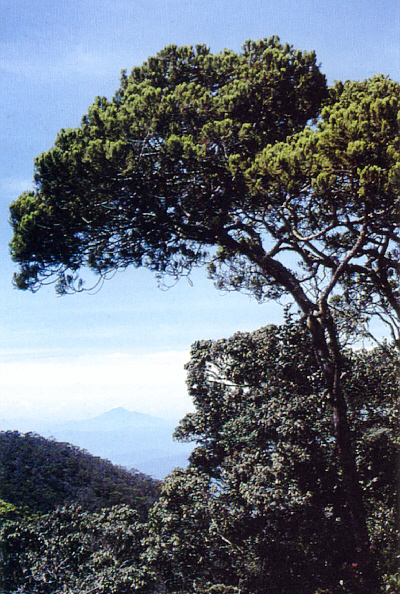
|
Podocarpus imbicatus
one of the most abundant
southern conifers of Mt. Kinabalu here growing at 9000'
|
|
|
|
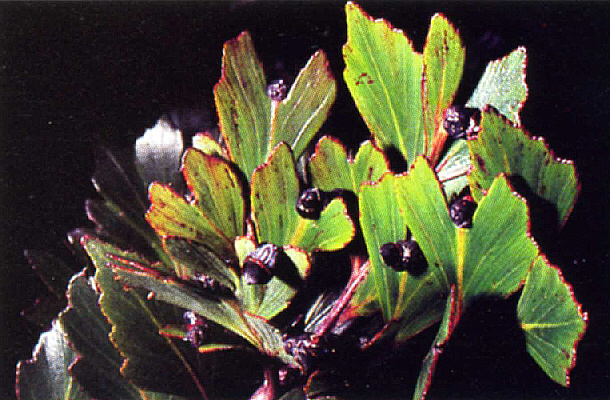
|
Phyllocladus hypophyllus the 'Celery Pine', a most
distinctive conifer. Note the small cones borne on
the phyllodes which substitute for leaves.
|
|
Our first few days on Kinabalu were spent in the headquarters area, making final arrangements for our climb and exploring the network of trails which have been developed by parks personnel. At this altitude (5100') the forests are part of the Tropical Lower Montane Forest Zone and are quite distinctive. Less species rich and structurally complex than lowland tropical rainforest, they are nevertheless amazingly rich in species by 'Pacific Northwest' standards, being composed of a heterogeneous array of tropical and northern and southern hemisphere temperate genera. Evergreen oaks (
Lithocarpus
) and Chestnuts (
Castanopsis
) predominate, but southern conifers are abundant as well. Most conspicuous are
Podocarpus imbricatus
whose foliage at these lower elevations looks not unlike that of
Sequoia sempervirens
, and the magnificent Kauri 'Pine',
Agathis borneensis
(syn.
A. dammera
), of the Araucariaceae, whose massive trunks and broad crowns usually extend well above the rest of the forest canopy. The 'Celery Pine',
Phyllocladus hypophyllus
, is another most distinctive and unlikely looking conifer which, along with
Podocarpus imbricatus
, extends in dwarfed form right up to the limit of trees at 11,500'. This conifer has no leaves, but instead has evolved flattened stem extensions or phyllodes upon which its small cones are borne. Two other trees from this zone should be mentioned. One of these,
Trigonobalanus verticillata
, caused quite a sensation in botanical circles when it was discovered in 1961 as, aside from being a new genus, it combined characteristics of true oaks (
Quercus
) with beeches (
Fagus
) and southern beeches (
Nothofagus
) and is thought now to be ancestral to the oaks. The other is perhaps the most conspicuous tree of these forests, as it has a smooth bright orange trunk reminiscent of
Arbutus menziesii
in the Pacific Northwest. It is
Tristania
, a close relative of
Eucalyptus
, and all of us agreed it would look much more at home in the sclerophyll forests of New South Wales than in the wet montane forests of Borneo. It is not to the trees, however, that one's attention is first drawn, but rather to the under story and especially to the ferns. The fern enthusiast could spend years here as these forests are home to as great a variety of ferns as are found anywhere on earth, and include a number of unusual genera such as the beautiful and elegant
Matonia
and
Lecanopteris
, the ant-fern, an epiphyte whose swollen rhizomes are home to ant colonies. In the mosses along the streams are begonias of several species and colorful clumps of pink flowered
lmpatients platyphylla
, while orchids and gesneriads occur in large numbers as epiphytes on the shrubs and trees. At this altitude rhododendrons seem much less common and conspicuous than in comparable forests in New Guinea and the only species we encountered was the little shrublet
R. quadrasianum
var.
cuneifolium
, unfortunately not in bloom. Tree-ferns and
Pandanus
, both so abundant in New Guinea, were also rather scarce. These forests are rich in birds and insects and one evening we were treated to a visit by an enormous Atlas Moth with a wingspread of about 10", a beautiful mosaic of velvety russets, browns and silvers. Oriole-like orange and black Mountain Minivets, Fantail Flycatchers, Malesian Tree-Pies, and many other birds give these beautiful forests an added dimension. Weeks could be spent exploring the vicinity of the park headquarters and only the surface would be touched. As it was we started the ascent feeling we had only glimpsed what these forests had to offer.
Like the Doleshys, we started our ascent from 6200' with Panar Laban our day's goal. Panar Laban is a locality at 11,000' on the south ridge where the sub alpine dwarf or moss forest gives way to the largely bare and steep granodiorite dome. Here are located two rather bleak aluminum huts which at least provided shelter from the torrential rain and howling winds that marked each night, though happily not each day, we spent up there! The ascent to Panar Laban is very steep, almost 5000' in only three and a half miles. That three mile trail must be, however, one of the botanically richest on earth with new and fascinating species appearing around literally every bend, so that very little excuse is needed for frequent rest or photography stops.
We had climbed only a very short distance when we saw our first rhododendron, appropriately one of the most distinctive on Mt. Kinabalu,
R. stenophyllum
. With its very narrow 3" long leaves and its glistening orange-red, bell-shaped flowers in clusters of twos or threes, it is unmistakable. Only a short distance further up the trail, beginning at 6500' and extending upwards to at least 8000', we found the almost equally distinctive
R. fallacinum
growing as a terrestrial shrub to approximately 15' high. This species appeared to be in almost full bloom and was very common, its bright scarlet umbels and wavy-edged, nearly sessile leaves noticeable features in the montane forest. At about 7000' we saw our only specimen of the incomparable
R. quadrasianum
var.
cuneifolium
, mentioned earlier, was common up to at least 8000', but we never did see it in bloom. I would again refer readers to Mr. Doleshy's 1977 paper for more complete descriptions of all these rhododendron species and their habitats.
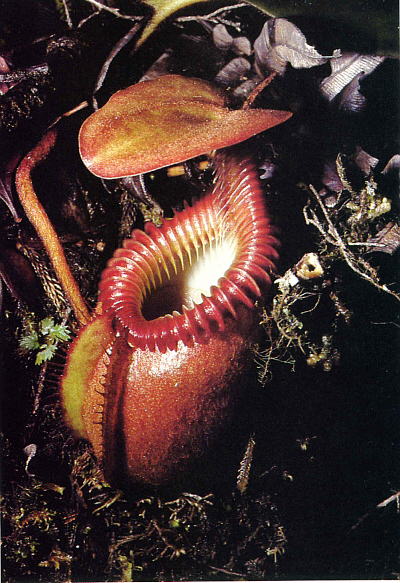
|
Nepenthes villosa
8000' one of the most
colorful pitcher plants of Mt. Kinabalu
|
This ascent, from 6,200' to 11,000', is for the most part in Tropical Upper Montane Forest, distinguished from the lower forest zone around park headquarters by generally shorter trees of fewer species, a greater proportion of conifers, and the absence of many lowland elements such as dipterocarps. The upper portion of this zone, from about 9,000' on, is a subdivision of the Upper Montane Zone known as sub alpine forest, cloud, or moss forest. There is little homogeneity about this whole upper zone however, and changes in the forest are to be seen with every gain of a few hundred feet of altitude. One of the most interesting variations is a narrow zone at around 7,500' of climbing bamboo of the genus
Racemobambos
which creates a most strange effect. This bamboo is very abundant and the dominant feature over its narrow attitudinal range, where it appears to swamp all other vegetation like an undulating carpet of underwater algae. Great festoons of it link the trees and shrubs like great green spider webs, an effect most pronounced in misty weather. Many other plants seen on this ascent are worth more attention, but I will confine my comments to a few of the, most notable. Of all genera on the mountain the tropical climbing pitcher plants of the genus
Nepenthes
are probably the most remarkable. Of the sixty-five species in this fascinating genus thirty are native to Borneo and of these at least nine are found on Kinabalu, including the largest and most bizarre members of the genus. Some species have brilliantly colored pitchers while others have pitchers of very odd shapes. The pitcher size ranges from a few inches to over fourteen inches long in the case of
Nepenthes rajah
which, unfortunately, we did not see. A smaller species,
N. tentaculata
, is abundant on the ascent trail and was often seen climbing
Rhododendron stenophyllum
, the pitchers of the former and the flowers of the latter forming a very pleasing composite picture. Far more spectacular were the large, ornate, brilliant orange, green, and yellow pitchers of
N. villosa
, met with frequently above 8000'. This species is certainly one of the most outstanding plants of Kinabalu and must be an exciting find to even the most single-minded rhododendron enthusiast!
Astilbe rivularis
, cream in colour and much like our garden hybrids in appearance, and beautiful pink flowered
Sonerila
, a small herb in the Melastomaceae, are mentioned as samples of the rich herbaceous flora. The beautiful southern conifer
Dacrydium beccarii
was much in evidence above 7,500' and arched above the steep path forming the forest canopy on steeper slopes.
Above 8000' on this route there is a dramatic change in the vegetation brought about by an equally dramatic change in rock type, from the acidic granodiorite which makes up the core of Kinabalu to a localized but fairly extensive outcrop of ultra basic rocks. On the serpentine soils formed on the ultra basics the trees are much smaller and species fewer in number than elsewhere, but the basic plant association appears quite distinct. It is dominated by
Leptospermum recurvum
, a small contorted tree in a genus of distinctly Australian origin. Also common is
Dacrydium gibbsiae
, a most beautiful small conifer with arching branches and narrow awl-shaped dark green needles. And in this association, having not met with a new rhododendron for some hours, we saw for the first time
R. ericoides
with its tiny heath-like leaves and brilliant red narrow tubular flowers. Though not by any means identical, the resemblance to
R. womersleyi
from the heights of Mt. Wilhelm is most striking, more from habitat and flower similarities than leaf similarity, although the New Guinea species also has tiny crowded leaves.
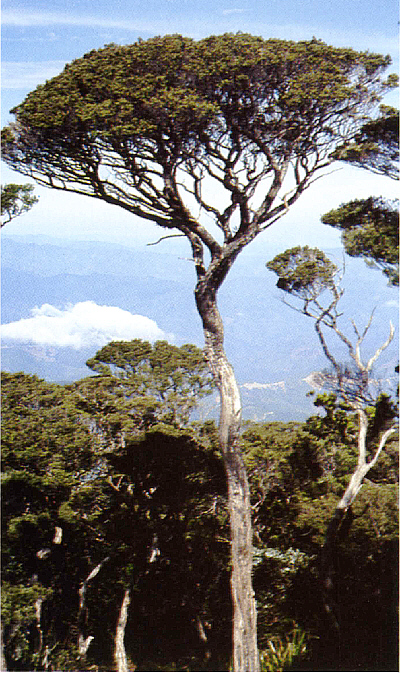
|
Leptospermum recurvum
- the dominant shrub or
small tree of the ultra-basic rocks and the summit
zone, Mt. Kinabalu
|
|
|
|
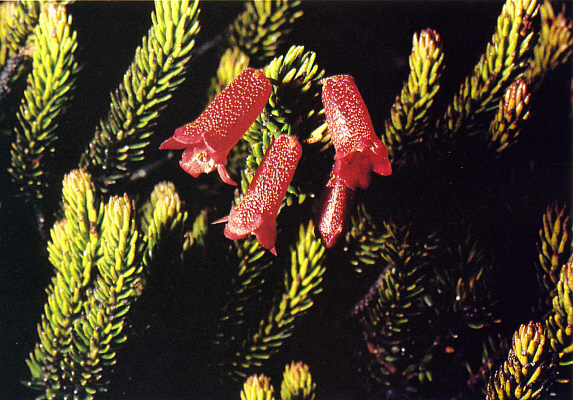
|
Rhododendron ericoides
10,500' 6' shrub of the forest edges summit zone
transition of Mt. Kinabalu.
|
|
|
|

|
R. womersleyi
Photo by Dr. L. K. Wade
|
|
At about 10,700' the mossy forest gradually gives way to the steep bare slopes of the Kinabalu summit zone, although fragments of forest extend well upwards to 11,500' or so in sheltered draws and large cracks in the smooth rock surface. The flora here is very interesting and the Ericaceae very prominent.
Rhododendron rugosum
var.
rugosum
, with rose crimson flowers, and
R. acuminatum
, with orange to scarlet flowers and pronounced acuminate leaf tips, were both in full bloom and quite magnificent. Both these species have leaves with deeply impressed veins and both grow to 10 or 15' in height.
R. buxifolium
var.
robustum
was also common and is notable for its blood red, rather fleshy flowers. Many plants were 15' or more in height, although, unlike the previous two,
R. buxifolium
occurred upwards to at least 12,000" where it was reduced to 3-4' in height. Numerous
Vaccinium
and
Diplycosia
species added to the ericaceous atmosphere, but few of these were in bloom at the time of our visit.
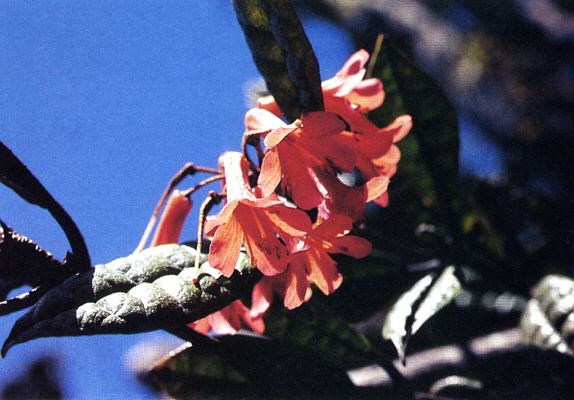
|
|
Rhododendron acuminatum
11,000' shrub vic. Panar Laban, Mt. Kinabalu
|
|
|
|
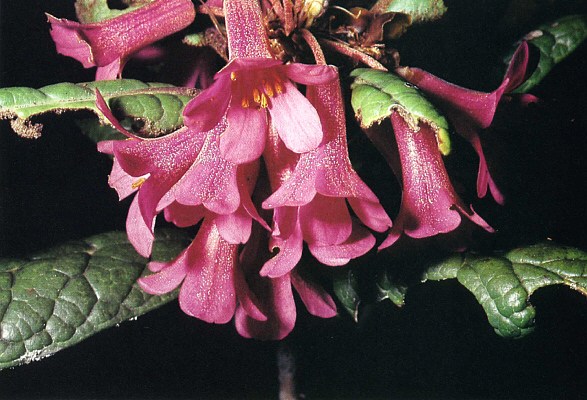
|
Rhododendron rugosum
var.
rugosum
11,000' often found associated with
R. acuminatum
, vic. Panar Laban
|
|
|
|
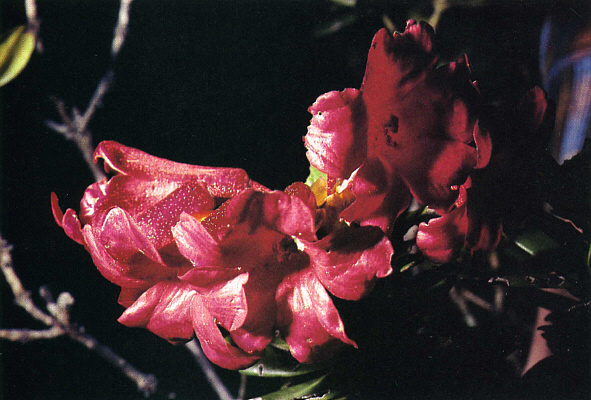
|
|
Rhododendron buxifolium
11,700' a species with very fleshy blood red flowers
|
|
Besides the Ericaceae, a number of other genera in the summit zone caught our attention,
Gentiana, Ranunculus, Potentilla, Drimys, Rubus, Styphelia, Coprosma, Trachymene, Euphrasia, Eria,
and
Photinia
, to name a few. Three plants really stood out and deserve a little more attention. The first was
Schima brevifolia
, one of the most beautiful shrubs I have ever seen. Growing to 10' in height, this member of the tea family (Theaceae) has pure white almost globular flowers, lustrous spherical red flower buds, and glossy dark green leaves with narrow red edges. A more exquisite plant would be difficult to imagine and, as it occurred up to 12,000', it might succeed in cultivation in sheltered areas such as the southern Oregon coast. The second species was a spectacular mistletoe,
Lepidaria subaensis
, with yellow tubular flowers clustered in a base of deep red bracts, somewhat reminiscent of the blood red
Amyema
species in the same family found at similar altitudes on Mt. Wilhelm. The third was a small shrub in the Rubiaceae or coffee family,
Hedyotis pulchella
, with light green glossy leaves and 1" white flowers with beautifully fringed tubular corollas. These were certainly among the most striking of the 'non-rhododendrons' in the area.
We spent four nights in the huts at Panar Laban and on our second full day in the summit zone climbed the highest summit, Low's Peak. We reached the summit plateau with its myriad of odd-shaped but most impressive peaks just as the mist and clouds closed in, but we were permitted a few minutes to gaze down into the great abyss of Low's Gully with its sheer precipices dropping thousands of feet, before swirling cloud obscured the entire scene. We enjoyed a few moments of partial clearing from the top of Low's Peak (13,455'), but completed most of our descent to Panar Laban in heavy cloud.
R. ericoides
occurs as tiny shrublets a few inches high in cracks in the rock of the summit plateau, at over 13,000', making it the highest growing rhododendron species on the mountain. Our other days in the summit zone were spent examining plants in the Panar Laban vicinity and around a higher but at Sayat Sayat, situated at about 12,000' on the summit climb route. Our weather ranged from overcast to scattered cloud, with little rain during the day but torrential rain each night. The day of our return to park headquarters dawned bright and clear and remained so all day, making the long hike down a delight. It must have been very windy on the summit plateau on this final day however, for even well below Panar Laban we could hear the wind shrieking between the summit peaks and watch as small ragged white clouds were flung skyward from Low's Gully.
After reaching park headquarters we made a flying visit to Poring Hot Springs at the east side of Mt. Kinabalu National Park to see
Rafflesia
in its natural habitat. This plant is parasitic on the roots of a woody liana and produces the world's largest flowers, 2-3' across and the colour of rotting meat. We were rewarded for our efforts by finding only the cabbage sized buds, but they were impressive enough. Several days in Singapore and a visit to the magnificent Singapore Botanic Garden ended our Southeast Asian tour.
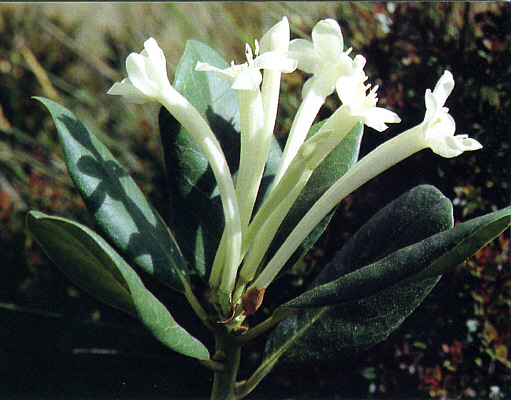
|
Rhododendron herzogii
9,000' a very fragrant small shrub of the
upper montane forest, Mt. Wilhelm.
|
It is interesting upon reflection to compare the rhododendrons of Mt. Kinabalu with those of Mt. Wilhelm or Enduwakombugu. We collected twenty-one species on Mt. Wilhelm during our extended stay in 1966-67, over an attitudinal range from 7000 to 13,500'. Most of these twenty-one species were either blood red or white, the latter species in each case having less common pale pink forms. These white species include
R. herzogii
,
R. pleianthum
, and
R. maius
. All were fragrant, usually epiphytic, were moth pollinated, and occurred below 9,000'. One pink species,
R. phaeochitum
, and one yellow to orange species, the ubiquitous
R. macgregoriae
, were also found below 9,000', but in general yellow and orange flowered species were as conspicuous by their absence on Mt. Wilhelm as white flowered species appear to be on Mt. Kinabalu. Above 9,000' all species on Mt. Wilhelm were bright red and bird pollinated, the altitudinal transition line between moth pollinated white flowered and bird pollinated red flowered species being remarkably well-defined. Corolla length in this group of red flowered species varies greatly and often closely matches the beak lengths of the different species of honeyeaters which pollinate them.
R. culminicolum
has corollas about 3-4" long,
R. atropurpureum
(which despite its name is bright red) and
R. commonae
have smaller corollas 2-3" long, while
R. gaultheriifolium
,
R. inconspicuum
, and
R. yelliotti
have tiny corollas an inch or less in length.
Ecologically, parallels might be drawn between
R. acuminatum
and
R. rugosum
of Kinabalu and
R. culminicolum
and
R. atropurpureum
of Wilhelm. All reach a similar height and occur mainly in the uppermost levels of the moss forest and along the forest edge of their respective mountains. Similarly
R. ericoides
of Kinabalu appears to be somewhat ecologically equivalent to
R. womersleyi
of Wilhelm, although it must be admitted that the latter does not extend upwards to the rocky summit zone as
R. ericoides
does. Other Mt. Wilhelm species such as
R. commonae
and
R. yelliotti
occur mostly in the Subalpine Tussock Grassland Zone mentioned earlier, for which there appears to be no equivalent on Kinabalu. It is tempting to draw parallels between the large white flowered lower altitude species of Wilhelm with the large yellow and orange flowered species of Kinabalu such as
R. lowii
and
R. retivenium
, but such a comparison would be premature. Despite the obvious differences between the two rhododendron floras, the parallels are quite striking and it would be most interesting to learn more of the pollination ecology and evolutionary backgrounds of these two beautiful groups of rhododendrons.
I would like to add a word of thanks to Mr. Frank Doleshy for the immense amount of help he gave us before our trip, in the form of advice, contacts, maps, publications, and slides. His efforts smoothed the way immeasurably and we are most appreciative.
Literature Cited
Corner, E. J. H. et al, 1962-63, Royal Society Expedition to North Borneo 1961: Reports. Proc. Linn. Soc. Lond., 175(1):9-56
Corner, E. J. H. et al, 1964, A Discussion on the results of the Royal Society Expedition to North Borneo, 1961, Proc. Roy. Soc., B, 161:1-91
Dingley, E. R. ed., 1978, Kinabalu Summit of Borneo, The Sabah Society, Kota Kinabalu
Doleshy, F. L., 1977, Rhododendrons on Malaysia's Highest Peak, Mt. Kinabalu, Quar. Bull. Amer. Rhod. Soc., 31(2):70-82
Gibbs, L. S., 1914, A Contribution to the Flora and Plant Formations of Mount Kinabalu and the Highlands of British North Borneo, Jour. Linn. Soc., (Bot.), 42:1-240
Mackinnon, J. et al, 1975, Borneo, Time-Life Books, Amsterdam
Meijer, W., 1963, A Botanical Guide to the Flora of Mt. Kinabalu, in Symposium on Ecological Research in Humid Tropics Vegetation, Govt. of Sarawak and UNESCO, Kuching, Sarawak, :325-359
Sleumer, H., 1965, Rhododendron in Borneo and Thailand, Jahrbuch 1965 der Rhododendron-Gesellschaft Bremen
Sleumer, H., 1966, An Account of Rhododendron in Malaysia (from Flora Malesians, ser. 1, vol. 6, part 4:473-674), P. Noordhoff, Groningen, The Netherlands
Wade, L. K., 1968, The Alpine and Subalpine Vegetation of Mt. Wilhelm, New Guinea, Australian National University
Zahl, P.A., 1964, Malaysia's Giant Flowers and Insect-trapping Plants, Nat. Geog., 125 (5):680-697










